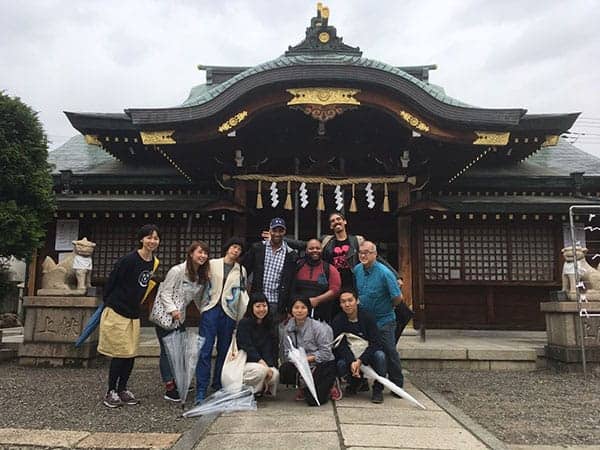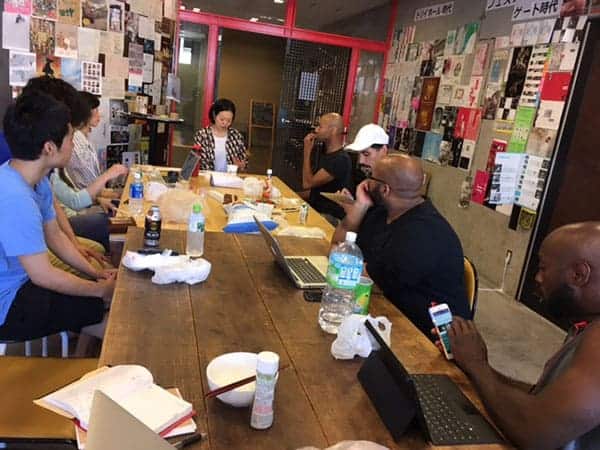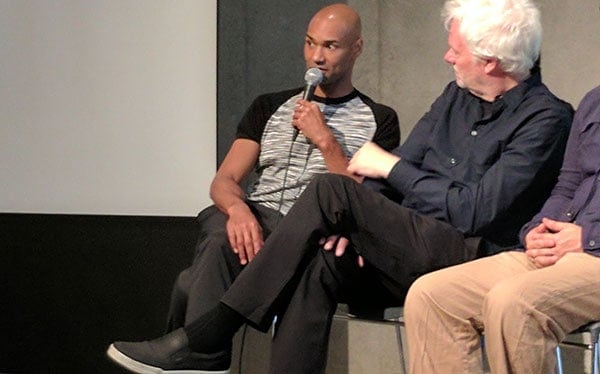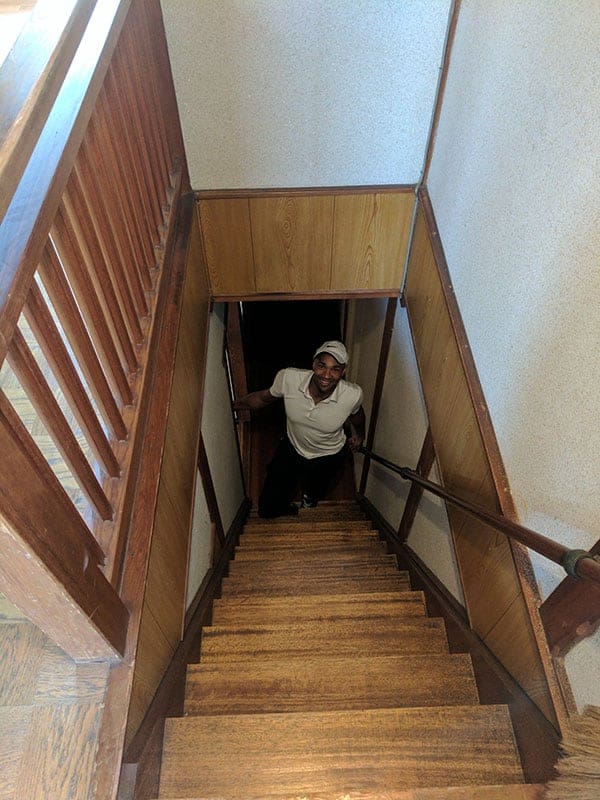Physical Translations: Notes and observations from a conversation with Darrell Jones, Justin Mitchell, and J’Sun Howard
August 11, 2017 • 9 minute read
By Grace Walters and Milena Berbenkova, Links Hall

Introduction
The US–Japan Connection is part of the International Program of the National Performance Network/Visual Artists Network (NPN/VAN). In 2014 as part of the project, Links Hall in Chicago, The Flynn Center in Burlington, Vermont, and Fusebox Festival in Austin, Texas, were selected to join three curatorial partners in Japan: Kyoto Experiment Festival, Dance Box in Kobe and NPO Arts Link for a three-year term to foster meaningful artistic and cultural exchange between Japan and the US. Led by Kyoko Yoshida, project director/consultant, the partners were able to learn about artists and organizations and the strengths and challenges of cultural production in Austin, Burlington, Chicago, Kobe, Kyoto, Portland, Rikuzen-Takada, Shiogama, Tokyo, Tulsa, and Yokohama.
Together the US–Japan curatorial team developed a new model of artistic exchange: providing concurrent residencies and performance opportunities in both countries for a Japanese dance artist and an American dance artist. Their goal was to create new works by learning from each other’s cultures and ways of making. This would build upon the strengths of Dance Box and Links Hall as incubators and The Flynn, Fusebox Festival and Kyoto Experiment Festival as presenters.
The two artists invited to partner with NPN’s US–Japan Connection team were Chicago-based choreographer Darrell Jones and Tokyo-based choreographer Kaori Seki. The first leg included a month-long residency in the US in November–December 2016 including Thanksgiving in Burlington, the NPN Annual Meeting in Austin, and three weeks working in the studios at Links Hall. Darrell and Kaori and their collaborators sat in on each other’s rehearsals, participated in each other’s workshops and warm-ups, and began their research into creating their separate new works.
The second leg took place in May 2017, as Darrell, Kaori and their collaborators then spent three weeks at Dance Box in Kobe furthering their research and development and offering workshops to the local community of dancers. Darrell and Kaori have returned to their home bases to further their works’ development. Darrell will premiere his new work CLUTCH at the Kyoto Experiment Festival in November 2017 followed by the Chicago premiere of CLUTCH at Links Hall in April 2018 on a shared weekend with Kaori Seki’s new work as part of a US tour.
Links Hall’s Associate Producer Milena Berbenkova and Apprentice Producer Grace Walters sat down with Darrell Jones and two of his collaborators, J’Sun Howard and Justin Mitchell, to learn more about their recent residency at Dance Box in Kobe.

During the residency at Dance Box in Kobe, Japan, Darrell Jones focused on community workshops as a method of building material for his new work CLUTCH. As an artist Jones has spent years analyzing oppression as it lives in the body and excavating how individuals accumulate identity and mirror culture through movement. CLUTCH responds meaningfully to the need to build interpersonal empathetic bridges between individuals. In this liminal space, he engages a powerful question about the ontological reality of oppression. Can we transcend oppressive structures through movement? And can we help one another to find restorative moments of liberation? Over the course of the residency Jones conducted workshops every other morning; Kaori Seki led workshops on the alternate dates. These workshops incorporated both choreographers’ ensembles as well as the Dance Box community.
Jones’ reflection on his experience developing CLUTCH in Kobe unveiled how significant cross-cultural engagement can be to uncovering the truths of our own culture’s oppressive forces. Spending workshop time with movers from another country, the choreographers were instantly able to start picking up small, embodied differences between the groups through the everyday postures and inherent movement patterns of the countries and communities in which they grew up. Working next to an international peer gave Jones the space to question how we have developed differently—what influences set personal patterns and shaped rhythms and reactions.
The first major difference the artists discussed was around sound and how it imprints or expresses itself on and from the body. Justin Mitchell shared, “I think as Americans we are pretty boisterous and noisy and that I think is reflected in the way we hold ourselves in space, especially as people of color, that is part of life. The celebration and the expression of that is through noise and that felt like a really stark contrast to being in Japan and their practice and kind of silence. And it was pretty quiet at night where we were living, like almost deadly silent. It was like we were out in the country, but we weren’t; we were in the city. And so there was this economy of noise.” Jones added, “I was going to use the word ‘volume’ because it also felt like in how space was shaped—of how the bodies use space—just the volume that they take up in space, the volume that we take up in space, the volume of the size of our country, the volume of the size of their country. The density of the size of their country. On a practical and also a subconscious level it affects the way you relate yourself in space, your volume and also your sound and the way that you hold your body. “
CLUTCH looks at how we have been trained to move by our cultures – how as a child Jones was trained to shun any “feminine” movements. Diving into a workshop-based creation process with Kaori without a shared verbal language created a platform for Jones to communicate in more embodied ways, unpacking movements that were socially impressed upon movers from the US and how they differed from movements socially impressed upon movers who were from Japan.
Even in simple tasks the American and Japanese dancers differed in physical expression. Finding himself submerged in this communal method of devising on an international field, Jones’ starting focus was on “translation,” speaking about the literal, verbal translation that he went through as he attempted to communicate verbally with Japanese dancers and movers, as well as the translation of physical communication he experienced in learning to understand the ways in which Japanese dancers moved.

Justin Mitchell, Darrell’s DJ/Sound Artist collaborator, noticed that “the language gap” regularly created situations where participants were “reaching for communal understanding.” Mitchell offered that “as individuals sometimes the Japanese dancers didn’t understand [Darrell’s] instruction, but as a group they seemed to pool their understanding and find a collective way of communicating.” Mitchell also noted “being able to communicate through music and movement was a bridge when language couldn’t fill in the gaps. We were able to communicate stories and foster understanding about who we were and that was a really powerful tool to have.” Over the process of watching these bodies with their different cultural accumulations communicate with each other, Jones became fascinated by “translations of movements in the body, how given a directive, a certain demographic of bodies might respond very differently.” For instance, when Jones cued with a hand gesture “to gather and be ready to move together” American dancers reacted by getting low to the ground and balancing on the balls of their feet, “like basketball players.” The Japanese dancers on the other hand responded by coming together and standing completely upright.
Initially Jones interpreted this posture as distancing or withholding from “readiness” until he saw a singer perform in a club in Kobe. In the crowded venue, the singer was sitting down and someone in the front recognized that they were blocking others’ view of the stage and squatted. Within seconds the entire crowd had dropped to the ground in the same position so everyone could see. The audience had assumed a state of readiness based on the needs of the specific scenario; they figured out how to be “ready” as a whole. He brought this back into the studio with the realization that the Japanese dancers were not un-ready in their upright position, but rather they were prepared to act together. Throughout the residency Jones sought these small differences of movement, posture, and embodied communication as the grounds where he could investigate the different cultural forces that shape physical vocabulary that unconsciously instruct or oppress bodies.
Since both Jones and his collaborators and Kaori Seki and hers observed each other’s studio time outside of the workshops, they were able to discover philosophical commonalities, especially around “disruption.” Mitchell observed that Seki’s work with her collaborators involved “a lot of balance work and off-balance work that was trying to get at disrupting this sense of what the body’s been conditioned into doing and behaviors of what the body’s used to doing.” Mitchell went on to say, “I think maybe that’s something we carry with us as Americans, too. As Black Americans, the ability to disrupt traditions in order to get at something new out of something old, to really access liberation.”
This new residency model functioned primarily as a peer-to-peer exchange. Jones and his ensemble brought experiences to share and received many in return. Reflecting on Seki’s rehearsals, Jones recalls watching his Japanese counterpart directing her ensemble through intricate weight-bearing exercises, pressing them to not take the simplest or most understood route, and complicating their physical engagements. Seki’s process of complicating movement was in counterpoint to Jones’ own process of finding ways to simplify. “I think our environment [in the US] is complicated,” Jones reflected. “[In Japan] I knew that I didn’t have to worry about certain things. I didn’t worry about my public safety. I let go of my guard while I was there, so it felt like my thought processes were a little simpler…. Whenever I get the opportunity to get in the studio and make things simple, it feels like a luxury.”
J’Sun Howard agreed that existing felt simpler in Kobe: “I could just go do the work and not have to look over my shoulder and think ‘oh, there’s a police car.’” Jones himself says he’s “still digesting” the difference and that when he returned home he held onto the sense of “Oh, I’m really calm. I’m so safe and when I wake up I’m going to have my tea” like in Japan. Jones eventually felt that the environment in the US was too different to maintain the tranquility. As a result, some of the work they are doing in the studio now is figuring out what influences from their time in Kobe will become part of CLUTCH and what influences won’t work for the project within their home environment.
The ensemble is definitely retaining the vocabulary of shared experiences that they now have after participating in Seki’s workshops. These communal, focused moments have made new imprints on their movement patterns that continue to affect their conversations about the development of the work. Jones didn’t feel like they learned a technique, per se, but rather they were able to “try things on their bodies.” They are continuing to acknowledge physical moments in their process that originated with experiences they shared with her but when placed on their bodies “morphs into something else.” Howard specifically pointed to “time,” which Jones referenced as “Kaori Pace” as a significant lingering influence from their shared experience with the Japanese choreographer. Howard implied that this pacing lingers because it resonated with the needs of the material they’re investigating: “If we’re talking about disruption or liberation, that takes a long time. I felt like when I was in [her] class it took time to get to where we needed to go.”
The American artists also mentioned how fruitful the low-pressure structure of the international exchange was for them. To Jones this process of shared experience rather than collaboration was “more beneficial to me than certain collaborations where we make something together. Sometimes that can be a good friction, but having an experience together that we can bring back to the work we’re doing feels very valuable.” Not having the pressure to collaborate allowed both artists and ensembles the opportunity to impact each other in a way that, according to Jones, didn’t “feel like appropriating movement, but referencing an experience we shared together.”
Jones says that like “Kaori Pace” other physical habits from their time in Kobe “emerge in my body sometimes.” In addition, Jones’ partner was able to join him in Japan toward the end of the residency, and Jones was able to witness first-hand the process of his partner’s body learning and adapting to the new culture’s movement patterns. “It was beautiful because I saw his body change because of the mass of the culture. I just saw him intuitively orient himself around that. It’s that kind of perspective, when you’re inside something you don’t see how it’s affecting you and you need somebody from the outside to be like ‘wow, your tone has changed.’”
Through NPN’s US–Japan Connection, Darrell Jones and the CLUTCH ensemble were able to witness the accumulation of culturally dictated physical identity and work across two different cultures to disrupt learned technique and ways of communicating. Jones, Howard and Mitchell promised to let us know how this experience continues to impact them as they have just started to process their experience.

One thing they are all certain of is they are grateful to NPN/VAN for the experience, especially as Jones worried, “I think we are at a time when these kind of programs might feel like they’re not important or like money might be diverted to other things.” For all four of the artists it was their first time in Japan and for Howard it was his first time out of the country. Jones, Howard and Mitchell all agreed that we can learn so much about ourselves—about our culture and how we move and think and feel—by spending time elsewhere. Jones hopes this article will “extend what we experienced to a wider group of people because not everyone gets the privilege to get out of this (gestured to encompass America).”
Darrell Jones: So thank you, thank you
Justin Mitchell: thank you
J’Sun Howard: Arigatōgozaimasu
Justin Mitchell: with a bow.